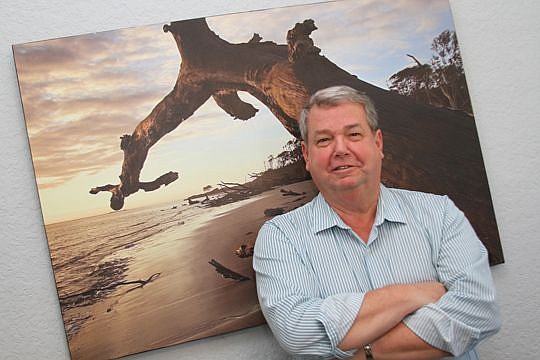
For many years, Jim McCarthy developed land for a living.
In the 1990s, he founded The Associated Builders and Contractors organization in Jacksonville and served as executive director.
He later worked for The Haskell Co., serving as vice president of business development, implementing development and design-build.
Now, McCarthy’s career involves preserving land, rather than developing it.
As executive director of North Florida Land Trust — a nonprofit dedicated to preserving important ecological, agricultural and historic lands of North Florida — he collaborates with landowners, public agency partners and other foundations to ensure the area’s natural resources are protected.
Founded in 1999, the land trust owns thousands of acres throughout the region, which McCarthy oversees, including the McGarvey/Goelz Preserve in Ponte Vedra Beach and the Nassau River Marshes and Big Talbot Island Preserves.
Its first purchase, Pescatello Island, is representative of the type of land the organization strives to protect.
A 30-acre forested island within the Timucuan Preserve, it has never been developed and now never will be. Surrounded by salt marshes, it is home to several types of birds and can only be accessed by boat, with permission.
The land trust recently identified thousands of additional priority areas in Duval, Clay, Putnam, Flagler, Nassau and St. Johns counties.
McCarthy and his staff are working on 44 projects, including the Spanish American War Fort in the Fort Caroline area, for which a closing date has been set for Nov. 3. The fund still needs to raise $21,000 to reach the purchase price of $400,000.
Since joining the land trust in August 2014, McCarthy said he is enjoying his new career because “it’s a real opportunity to make a difference.”
But he also stresses he is still in the real estate business and still in the business of buying land. In fact, he said, his experience in the development side has proven to be an asset when it comes to preservation.
“Companies like Haskell buy to develop and build,” and at the land trust, “we buy to conserve and preserve,” he said.
But, “we can work together,” McCarthy said.
Developers increasingly recognize the value of preserved lands — protected waterways, streams and rivers — because they enhance a community’s quality of life and increase nearby property values.
As a result, he said, preserving land has become “an opportunity to share, a common goal.”
Two developers recently approached the land trust about donating or selling unused mitigation property, primarily wetlands.
And they are in conversation with Gate Petroleum about possibly acquiring its Outpost property at the end of Neck Road in Ponte Verdra Beach.
The natural wooded land, long used as a retreat, is under contract with developers who plan to build a 77-home community, but only if it can be rezoned residential.
The land trust does not get involved with zoning issues, but “if they are unsuccessful in developing it, we would be more than happy to acquire it,” McCarthy said.
Ownership, however, is not the only way the land trust works to preserve land.
It also facilitates conservation easements between landowners and government agencies.
In those legally binding arrangements, a property owner retains ownership but gives up the right to develop the land, for a dollar amount or significant tax deduction.
Conservation easements are “a growing piece of our business,” McCarthy said, and the trust currently has projects underway to help farmers and ranchers turn their property into easements.
They also are involved with “facilitated acquisitions,” in which they help property owners donate land to a city, county or organization, such as a university.
This year, the land trust assisted with the donation of 33 acres at McGirts Creek to the city of Jacksonville.
The land trust has so many projects on so many fronts that the growing organization has doubled the size of its staff since McCarthy came aboard.
The nonprofit was based in Ponte Vedra Beach until March 2014, when the Chartrand Foundation donated a historic house and a lot on Gilmore Street.
The house, built in 1912, serves as a suite of offices for McCarthy and his full-time staff members: Land Protection Director Marc Hudson, Outreach Coordinator Genevieve Fletcher, Stewardship Manager Elizabeth Guthrie, Operations Manager Cassie Froeba, Legal Extern Connor Lunt and Land Protection Specialist Aaron Glick.
McCarthy said the trust was grateful for the donation of the Gilmore property, which recently won an award from the St. Johns Riverkeeper for its “river-friendly” front yard.
“We have a $9 million bottom line, but it’s like being house poor, because all of our assets are in land,” he said.
In order to succeed in its mission, the land trust is continually involved with fundraising, including through projects such as planned giving.
Their operating area encompasses 3 million acres, including coastal salt marshes, pine forests, swamps and other important ecosystems.
The trust has identified 112,000 of those acres as high priority lands to be preserved, including areas around Black Creek, Black Hammock Island, the Guana River, Lofton Creek, Crescent Lake and the Ortega River.
Florida’s population is expected to double by 2060, according to the trust’s preservation portfolio. So, as stated in the portfolio, it is important to protect the “scenic beauty, abundant wildlife, recreational opportunities and overall quality of life” in the region.
At Pescatello Island, the land trust maintains a trail for nature lovers that runs along the northern shore. With permission, the public can get to it via kayak or small boat from nearby Clapboard Creek or Bogey Creek Landing, which the land trust also owns.
Gliding over there, across the water, “it’s serene salt marsh, tons of wading birds,” said Guthrie. “Eagles, ospreys, blue herons, bald eagles. I once saw dolphins riding next to our boat.”
Protecting lands such as those drives McCarthy now.
“Eighty-four percent of the people in Jacksonville say they live here because they love the outdoors,” he said. “It’s part of who we are and where we are.”